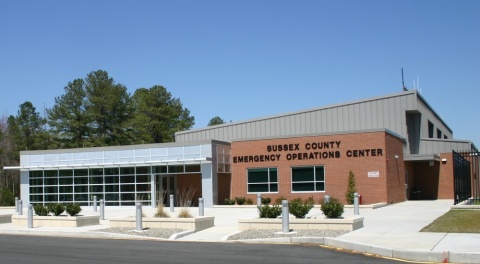
Georgetown, Del. (Wed., Nov. 30, 2016): Seasons change, but having a readiness plan for severe weather should be a constant for every home and business.
The Sussex County Emergency Operations Center reminds the public that preparation is a must before any season, whether it’s ahead of hurricane season that runs from June to November or the nor’easter season that spans October to March. Residents are encouraged to check supplies, monitor weather conditions, and take appropriate action if directed this winter season.
“Severe weather doesn’t end with the flip of the calendar,” Sussex County EOC Director Joseph L. Thomas said. “Hurricane season always gets a lot of attention, and for good reason. But the reality is coastal storms in the winter months bring their own set of weather challenges – snow, rain, ice, winds and flooding – that can cause damage just as easily as a hurricane, tornado or thunderstorm can. So it’s best for the public to always be prepared, regardless of the season.”
Over the years, Sussex County has experienced its fair share of harsh winter seasons, including the “polar vortex” that brought extreme cold to the region in early 2014, as well as back-to-back blizzards in 2009 and 2010 that closed schools, stranded motorists, scoured beaches, and knocked out power across the county.
The National Oceanic and Atmospheric Administration’s seasonal outlook for this winter (December through February) predicts equal chances for above normal, normal or below normal precipitation and temperatures in Sussex County. Forecasters in mid-October, when the outlook was released, said there is uncertainty about this winter, in part because of a weak La Niña pattern, the phenomenon of cooling waters in the east-central Pacific Ocean that can have global effects. That often leads to drier and warmer conditions, particularly in the southeastern United States. Still, coastal storms could form, bringing with them snow, rain, wind and flooding, if the jet stream is able to dip far enough to the south, and steer those systems up and along the East Coast.
To ensure you are prepared for winter weather, the Sussex County EOC suggests the following preventive actions:
Before the Storm
- Spread an ice melting agent on walkways and driveways to keep surfaces free of ice; use sand to improve traction;
- Have snow shovels and other equipment handy;
- Winterize your vehicle:
- Ensure antifreeze levels are sufficient to avoid freezing;
- Ensure the heater and defroster work properly;
- Check lights and flashing hazard lights for serviceability;
- Pack a winterization kit that includes an ice scraper, de-icer for door locks, blankets, and sand or kitty litter to provide traction if your vehicle becomes stranded;
- Create a Safety Profile for your household with the County’s free Smart911.com service to provide potentially critical, life-saving information up front.
During the Storm
Listen to television, radio, or NOAA Weather Radio for weather reports and emergency information. Also, visit the Sussex County EOC website and its social media channels, including Facebook at www.facebook.com/SussexCountyEOC and Twitter at twitter.com/SussexCtyDE_EOC, for up-to-date information;
- Eat regularly and drink ample fluids; avoid caffeine and alcohol;
- Conserve fuel and power, if necessary, by keeping your residence cooler than normal. Temporarily close off heat to some rooms;
- Limit unnecessary travel and heed all advisories and warnings.
Dress for the Weather
Wear layers of loose-fitting, thin, warm clothing rather than one layer of heavy clothing. Outer garments should be tightly woven and water repellant;
- Wear mittens, which are warmer than gloves, as well as a hat;
- Cover your mouth with a scarf to protect your lungs.
For more winter weather information and helpful tips, please visit the Sussex County website at sussexcountyde.gov/emergency-preparedness and click on the ‘Other Hazards’ link on the left to download a useful guide about preparing for winter storms and other types of hazardous events.
###

